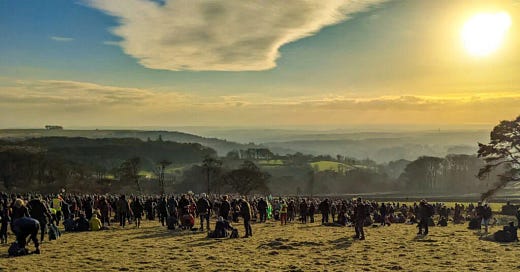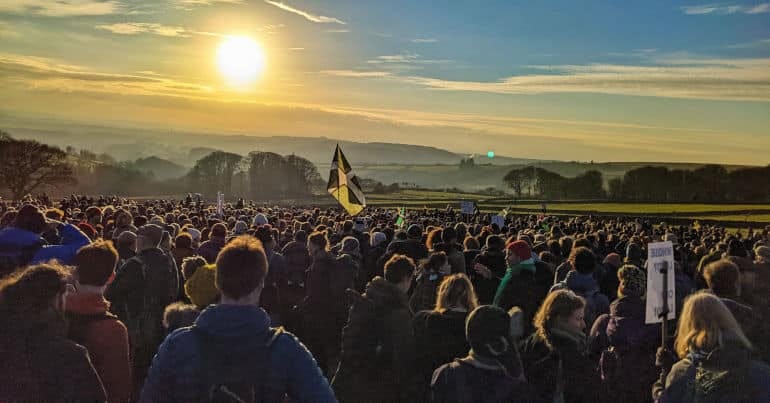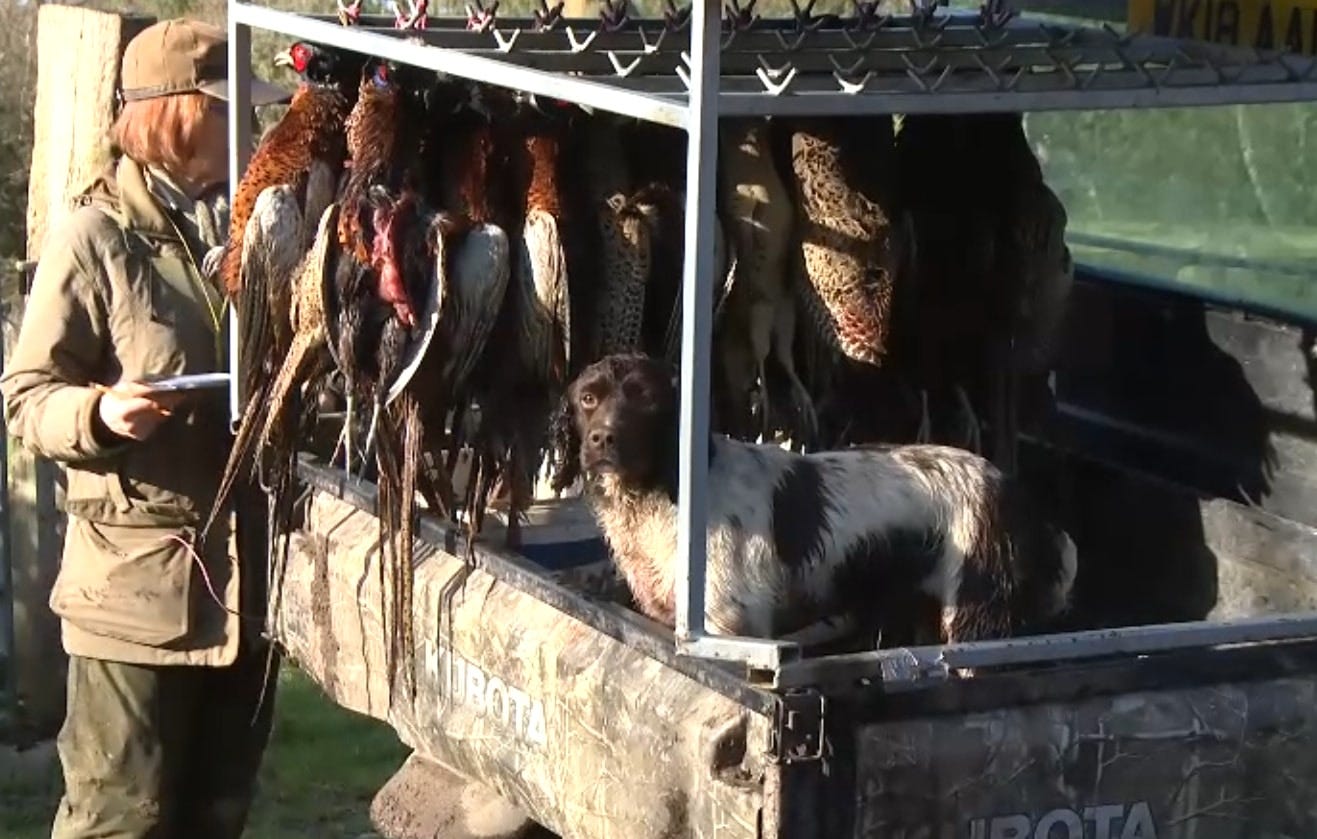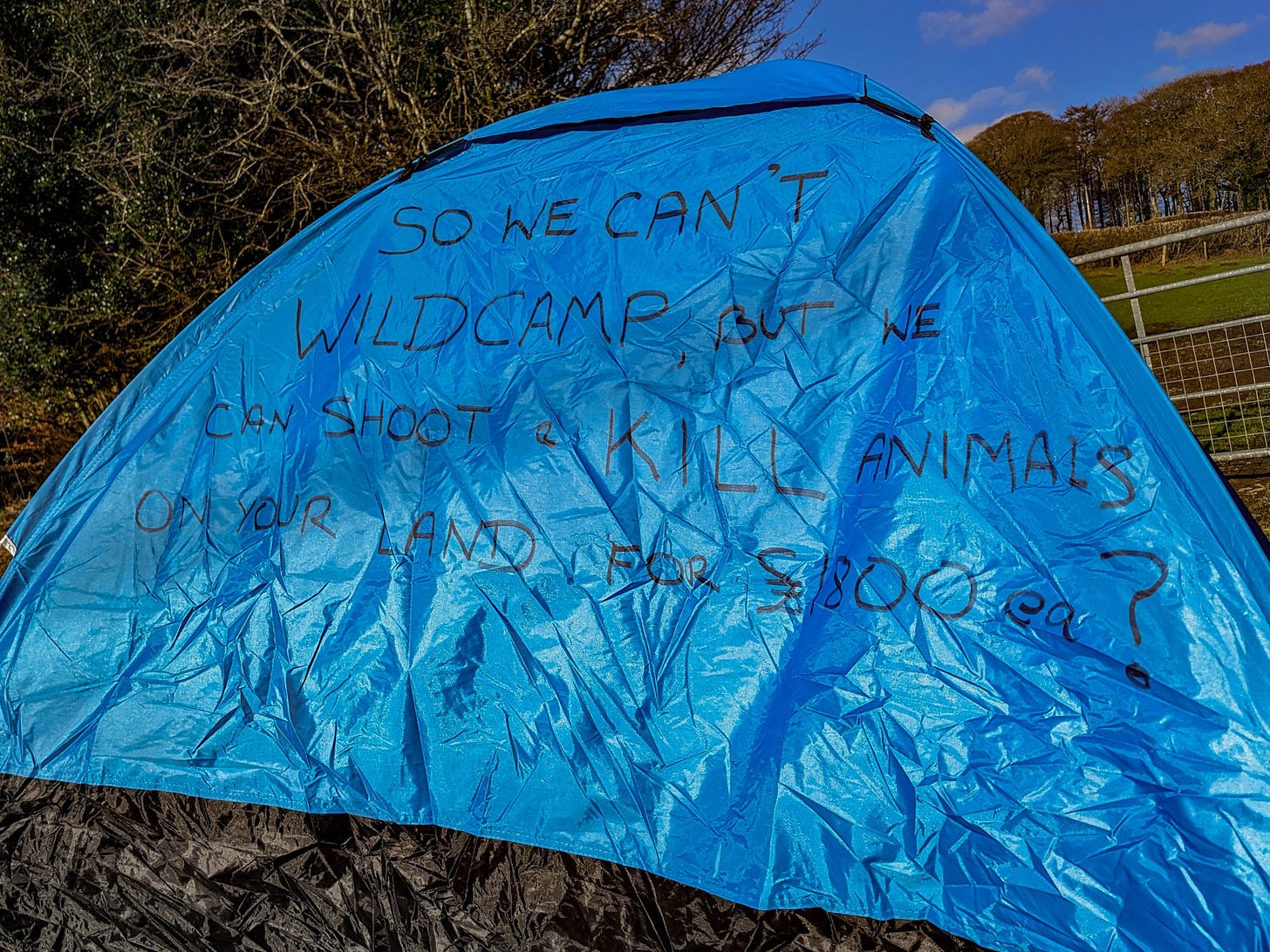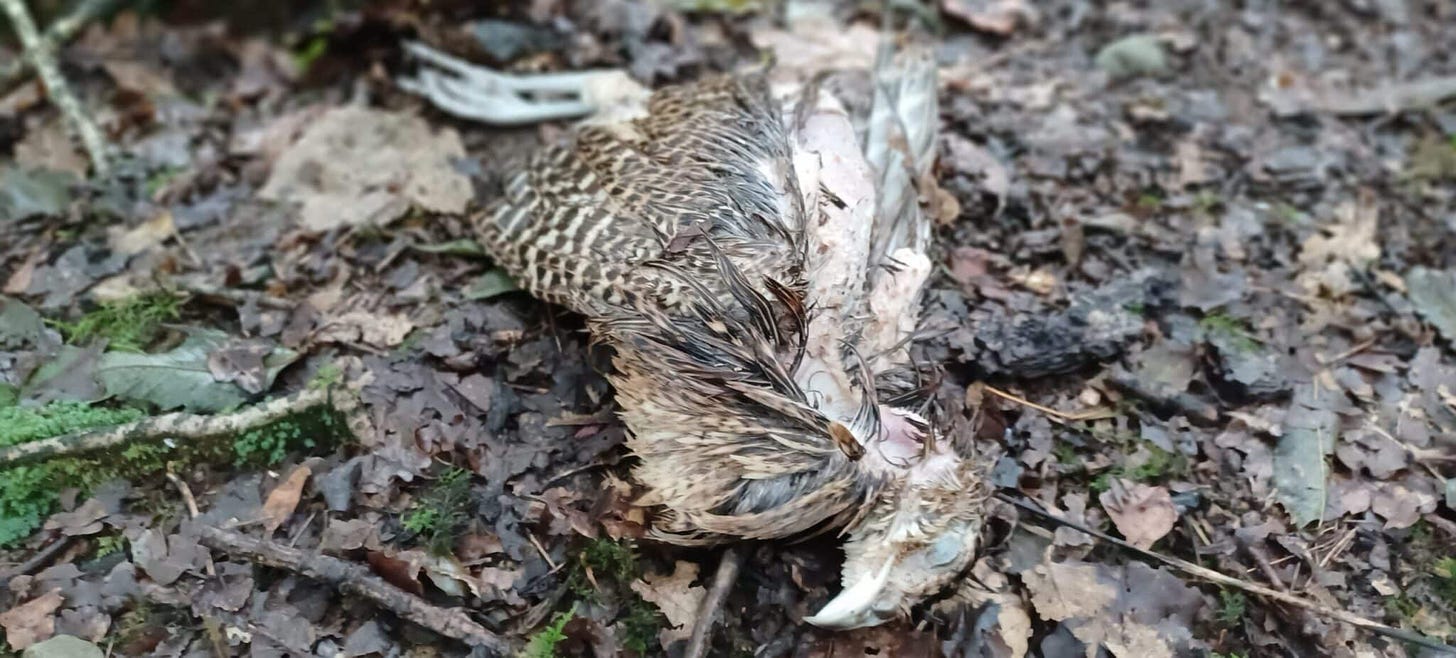DARTMOOR: camping ban and pheasant shooting
Darwall’s use of his land for bloodsports shows that he has little concern for conservation,
On Saturday 21 January, Protect the Wild joined more than 3,000 people marching in protest on Dartmoor after a pheasant-shooting millionaire took action to prevent wild camping.
Hedge fund manager Alexander Darwall, who owns the 4,000-acre Blachford Estate on Dartmoor, brought the case against Dartmoor National Park Authority (DNPA). The high court ruled in his favour, ending the legal right to wild camp on the moor.
Central to Darwall’s argument was his apparent concern for conservation on the moor. After the ruling, he and his wife Diana said:
“We now hope to engage with the Dartmoor National Park Authority, so that we can improve outcomes on the ground. Working together, we can improve conservation of the Dartmoor commons and improve the experience for those enjoying the commons legitimately.”
But Darwall’s use of his land for bloodsports shows that he has little concern for conservation, despite his arguments in court.
‘250 birds per day’
As the protest marched through Darwall’s land, the squawk of pheasants was ever-present. The millionaire uses his vast estate for pheasant shooting and deer stalking, which must make him a tidy sum.
Since the high court ruling, the Blachford Estate’s website has been set to private. But here’s a screenshot of the bloodsports page:
Meanwhile, the Cornwood Shoot website boasts that it:
“shows outstanding pheasants perfectly driven and well spread along the line. Dartmoor never fails to deliver picturesque views, with its traditional stone walls, open moorland and scenery for miles – creating an impressive landscape and topography that lends itself well to this type of shooting.”
It continues:
“We offer driven days from 250 up to 400 birds. Double guns can be arranged. We normally do 4-6 drives in a day but Back to Back days can be offered, providing around 250 birds per day. We can also arrange double days with our neighbouring shoots…
Shooting doesn’t get much better than this.”
Up to 50 million pheasants released per year
The argument that such bloodsports are essential for the conservation of land is an age-old lie, thrown around by rich land owners and the hunting elite alike. Far from being good for the land, pheasant-shooting is actually extremely detrimental.
Estates such as Darwall’s rear their own pheasants. Up to 50 million pheasants are released into the British countryside every year, to be shot for ‘sport’. In fact, the density of pheasants reared and released in the UK greatly exceeds that of any other country in Europe. Most of the birds released are imported from Europe – usually France – and chicks are reared in pens on the estates. Of the 50 million pheasants and 11 million partridges released into the countryside each year, around 30% are shot for ‘sport’. The others die of disease, starvation and are taken by predators, such as foxes.
After pressure from Wild Justice, in 2020 Defra finally added the common pheasant to Schedule 9 of the Wildlife and Countryside Act, which lists species that cause ecological, environmental or socio-economic harm. This means that shooting estates now need to abide by the rules of a general licence to release pheasants, but only if they’re located near to a protected site, such as a site of special scientific interest (SSSI). Even so, the number of birds that can be released under licence is still obscene. The government states:
“The density of common pheasants released within a European site must be no more than 700 birds per hectare of release pen, or lower if required by a site of special scientific interest (SSSI) consent. Any release, including single or trickle releases, must not exceed this limit.”
‘Ecologically nonsensical’
On top of all this, pheasants endanger other scarce beings. Protect the Wild’s Charlie Moores has stated that:
“Common pheasants are omnivores – meaning they will eat pretty much everything. Releasing millions of birds with large appetites (these are relatively large birds, remember) into an already depleted landscape is ecologically nonsensical. Common pheasants have been recorded catching scarce reptiles like slow worms and amphibians, and the birds that survive the early winter will take food needed by native seed-eating species during what is called the ‘hungry gap’ when everything is in short supply and wild birds are beginning to enter the breeding season.”
Indeed, on 21 January 2023, The Guardian reported:
“[Darwall] may be putting a rare beetle at risk by releasing pheasants next to an ecologically important woodland, against the advice of environmental experts.”
It continued:
“Dendles Wood is one of only a handful of sites in the UK where the large and distinctive beetle makes its home. It is found at just 15 sites in England and Wales, eight of which are in Dartmoor national park.”
Releasing pheasants next to an SSSI
The newspaper reported that Natural England has issued a warning to Darwall’s estate:
“Natural England, the government body in charge of enforcing conservation measures in national parks, has warned the estate not to release pheasants near Dendles Wood, a fragment of temperate rainforest on the southern edge of Dartmoor, adjacent to the Blachford estate. It is protected as a national nature reserve (NNR) and site of special scientific interest (SSSI), and falls within the Dartmoor special area of conservation (SAC).”
The Guardian stated that a pheasant release pen was placed on the Darwall’s land just 250 metres from the edge of the nature reserve. Under the government’s general licence conditions, the Darwalls are likely to be breaching the law, since they haven’t reported the number of pheasants released near to Dendles Wood.
Cruelty to wildlife
Of course, Darwall isn’t the only estate owner who claims to want to keep the public off his land for the greater good. Many estates use barbed-wire fences and ‘PRIVATE’ signs to prevent us from roaming the countryside. But as Protect The Wild has previously reported, it is land owners who trash the land and abuse the pheasants they’re rearing. In May 2022 we reported that a mass grave of pheasants was found by Right to Roam campaigners on the Duke of Somerset’s land. A number of blood-stained pheasant carcasses, tangled up with old wire fencing and other rubbish, were found in a large pit.
And an undercover investigation, carried out by the Hunt Investigation Team (HIT) and supported by Protect The Wild in September 2022, found disgraceful conditions at the Leighton Hall pheasant shoot in Lancashire. HIT found:
Pheasant pens containing numerous dead and dying birds.
Dying birds gasping for breath, arching their necks, exposing frail, skeletal, featherless bodies.
Weaker pheasants aggressively pecked and even potentially cannibalised by others.
Dead pheasants being cannibalised.
Prone birds whom investigators could barely believe were still alive in such appalling condition.
Water troughs and feeders which were empty and covered in excreta/scum at the time of our visit.
It isn’t just pheasants – and the creatures they eat – who are victims of this terrible industry. Predators such as foxes and corvids are targeted by shooting estates, unnecessarily murdered in order to keep their pheasants alive for shooting. Corvids are usually caught in Larsen traps, while foxes are caught in snares. Protect The Wild states that:
“The estimated number of fox snares put out in England is between 62,823 and 188,283 depending on the month; and in Wales the numbers are between 17,231 and 51,641. Approximately 1.7 million animals are caught in snares every year. Most of these animals are killed by the shooting industry to ‘protect their birds’ long enough for them to be sold off to shooters to be killed.”
Meanwhile, birds of prey are also targeted by the shooting industry. Raptor persecution is rife, through both trapping and poisoning, and a number of gamekeepers have been found guilty of murdering birds of prey. In April 2022, another covert investigation by HIT found crow cage traps on the Hilborough Estate in Norfolk had been used illegally to trap birds of prey using pigeons as bait.
In November 2022, Protect The Wild reported that:
“The latest RSPB Birdcrime Report confirms that the shooting industry continues to drive the illegal persecution of birds of prey, listing 108 confirmed incidents across Britain in 2021. The tally of dead birds includes 50 common buzzards, 16 red kites, seven peregrines and three goshawks.”
Wrecking our countryside
On top of all this, the shooting industry is responsible for polluting the land through the use of lead shot. Industry figures suggest that as many as 260 million cartridges are used. Protect The Wild’s Charlie Moores has stated:
“Each cartridge fired ejects about 300 pellets of lead. Every year therefore tens of thousands of tonnes of lead is fired across fields, moorlands, and woodlands, where it contaminates soil and water. Spent lead risks the health of wild birds that mistakenly ingest lead shot with prey or (in the case of waterfowl like some ducks and swans) swallow it instead of small stones to grind down food in their gizzards. Poisoned birds die slow, agonising deaths, as frequent firsthand reports from the likes of Wildfowl and Wetland Trust attest.”
Moores continued:
“Even the usually ‘neutral’ BBC was prompted to note in early 2021 that ‘almost all pheasants sold for food in the UK contain toxic lead shot’. The BBC was commenting on a report in Conservation Evidence which found that ‘of 180 birds examined by the scientists, 179 were shot with lead’, concluding that a voluntary five year phasing out of lead shot by the shooting industry had ‘not yet had a detectable effect on the ammunition types used by shooters supplying pheasants to the British game market’.”
It’s not over
It remains to be seen whether any action will be taken against the Darwalls for their apparent misuse of General Licence 43 by releasing pheasants near Dendles Wood. The penalty is either a six-month custodial sentence or a fine of any amount, and can result in the General Licence being withdrawn. His money will, perhaps, make Alexander Darwall feel invincible – after all, through his wealth he can win high court battles and donate thousands to his local Tory MP.
The Dartmoor National Park Authority is considering appealing the high court decision preventing wild camping on Dartmoor. In the meantime it has reached a ‘compromise‘, where it must pay estate owners to allow the public to wild camp in limited areas.
Darwall may think he has won his battle to prevent the public from camping on Dartmoor, but he has, in fact, angered a whole new generation of activists who will fight him, not just for their right to roam, but for the land and the life on it to be treated with respect.
Featured images of Dartmoor via Eliza Egret

